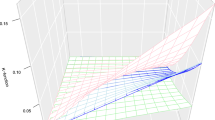Abstract
A novel estimator for the parameters governing spatial–temporal point processes is proposed. Unlike the maximum likelihood estimator, the proposed estimator is fast and easy to compute, and does not require the computation or approximation of a computationally expensive integral. This parametric estimator is based on the Stoyan–Grabarnik (sum of inverse intensity) statistic and is shown to be consistent, under quite general conditions. Simulations are presented demonstrating the performance of the estimator.





Similar content being viewed by others
References
Baddeley, A., Turner, R. (2005). Spatstat: An R package for analyzing spatial point patterns. Journal of statistical software, 12, 1–42.
Baddeley, A., Turner, R., Møller, J., Hazelton, M. (2005). Residual analysis for spatial point processes (with discussion). Journal of the Royal Statistical Society: Series B (Statistical Methodology), 67(5), 617–666.
Berman, M., Turner, T. R. (1992). Approximating point process likelihoods with glim. Journal of the Royal Statistical Society: Series C (Applied Statistics), 41(1), 31–38.
Błaszczyszyn, B., Schott, R. (2003). Approximate decomposition of some modulated-Poisson Voronoi tessellations. Advances in Applied Probability, 35(4), 847–862.
Błaszczyszyn, B., Schott, R. (2005). Approximations of functionals of some modulated-Poisson Voronoi tessellations with applications to modeling of communication networks. Japan Journal of Industrial and Applied Mathematics, 22(2), 179–204.
Cronie, O., Van Lieshout, M. N. M. (2018). A non-model-based approach to bandwidth selection for kernel estimators of spatial intensity functions. Biometrika, 105(2), 455–462.
Daley, D. J., Jones, D. V. (2003). An introduction to the theory of point processes: Elementary theory of point processes. New York, NY: Springer.
Daley, D. J., Vere-Jones, D. (2007). An introduction to the theory of point processes: General theory and structure. New York, NY: Springer.
Diggle, P. J. (2006). Spatio-temporal point processes, partial likelihood, foot and mouth disease. Statistical Methods in Medical Research, 15(4), 325–336.
Diggle, P. J., Kaimi, I., Abellana, R. (2010). Partial-likelihood analysis of spatio-temporal point-process data. Biometrics, 66(2), 347–354.
Harte, D. (2010). Ptprocess: An R package for modelling marked point processes indexed by time. Journal of Statistical Software, 35, 1–32.
Krickeberg, K. (1982). Processus ponctuels en statistique. In ecole d’eté de probabilités de saint-flour X-1980 (pp. 205–313). Berlin, Heidelberg: Springer.
Ogata, Y. (1978). The asymptotic behaviour of maximum likelihood estimators for stationary point processes. Annals of the Institute of Statistical Mathematics, 30(2), 243–261.
Ogata, Y. (1998). Space-time point-process models for earthquake occurrences. Annals of the Institute of Statistical Mathematics, 50(2), 379–402.
Ogata, Y., Katsura, K. (1988). Likelihood analysis of spatial inhomogeneity for marked point patterns. Annals of the Institute of Statistical Mathematics, 40(1), 29–39.
Reinhart, A. (2018). A review of self-exciting spatio-temporal point processes and their applications. Statistical Science, 33(3), 299–318.
Schoenberg, F. P. (2013). Facilitated estimation of ETAS. Bulletin of the Seismological Society of America, 103(1), 601–605.
Stoyan, D., Grabarnik, P. (1991). Second-order characteristics for stochastic structures connected with Gibbs point processes. Mathematische Nachrichten, 151(1), 95–100.
Acknowledgements
Thanks to Adrian Baddeley for suggesting estimation based on kernel smoothing the scaled residual field, to Peter Diggle for suggesting the partial likelihood as an alternative way of avoiding having to compute the integral in the MLE, to Aila Saarka for suggesting that the SG estimator could be used to obtain starting values for the MLE, and to James Molyneux for his work on selecting partitions. This material is based upon work supported by the National Science Foundation under grant number DMS-2124433.
Author information
Authors and Affiliations
Corresponding author
Additional information
Publisher's Note
Springer Nature remains neutral with regard to jurisdictional claims in published maps and institutional affiliations.
About this article
Cite this article
Kresin, C., Schoenberg, F. Parametric estimation of spatial–temporal point processes using the Stoyan–Grabarnik statistic. Ann Inst Stat Math 75, 887–909 (2023). https://doi.org/10.1007/s10463-023-00866-6
Received:
Revised:
Accepted:
Published:
Issue Date:
DOI: https://doi.org/10.1007/s10463-023-00866-6




